Abstract
The influence of solid solution treatment (SST), artificial aging treatment (AAT), and deep cryogenic-aging treatment (DCAT) on the mechanical properties and microstructure evolution of 6082 aluminum alloy was investigated. The tensile test was performed to obtain the true stress–strain curves through an electronic universal testing machine. The results show that the yield strengths of the SST specimens in all three directions are the lowest, of less than 200 MPa. In addition, the maximum elongation of the SST specimen is over 16% and the value of in-plane anisotropy (IPA) is 5.40%. For the AAT specimen, the yield strengths of the AAT alloy in three directions have distinct improvements, which are beyond 340 MPa. However, the maximum elongation and the IPA were evidently reduced. The yield strength and elongation of the DCAT alloy exhibit a slight enhancement compared with those in the AAT condition, and the corresponding IPA is 0.61%. The studied alloy specimens in all conditions exhibit ductile fracture. The DCAT alloy has the highest density of precipitates with the smallest size. Therefore, the dislocation pinning effect of the DCAT specimens are the strongest, which exhibit the highest yield strength accordingly. In addition, the uniformly distributed precipitates in the matrix with a large ratio of long and short axes can suppress the anisotropy caused by elongated grains.
1. Introduction
As one of the most potential materials in recent decades, aluminum alloy has the advantages of high specific strength, low density, and convenient recycling [1,2,3]. Among them, 6000 series aluminum alloys also demonstrates preferable forming performance, excellent processing properties and satisfactory corrosion resistance [4]. Thus, it plays an important role in social economic development and the manufacturing of parts, especially in the automotive industry [5]. Automobile components such as luggage racks, bumpers, wheel fenders, and so on are fabricated using 6000 series aluminum alloys [6,7]. In addition, the application of aluminum alloy material in automobile body structures is one of the most important approaches to realize lightweight vehicles. However, in the process of producing medium–high-strength 6000 series aluminum alloy by adopting traditional heat treatment methods, scientists and engineers still encounter some obstacles to achieve an optimal combination of strength, plasticity, and uniformity. This problem not only reduces the service performance of the relevant aluminum alloy components, but also limits the further extension of the material application field. Therefore, it is of great significance to study the mechanical properties and microstructure evolution of aluminum alloy under different heat treatment processes.
The main components of 6000 series alloy are Al, Mg, and Si elements. The mechanical properties of this alloy can be strengthened by a heat treatment process [8,9]. Therefore, it is crucial to study the effect of heat treatment on mechanical properties and the microstructure evolution of aluminum alloy materials. Generally speaking, the aluminum alloy can obtain a favorable mechanical property through solid solution treatment (SST) and aging treatment. During the SST process, the second-phase particles in the alloy can be dissolved into the aluminum matrix; meanwhile, the solute atoms return to the aluminum matrix. Therefore, aluminum alloy turns into a supersaturated state. Subsequently, adopting different aging processes, precipitation will occur in the supersaturated matrix. The precipitates can effectively improve the strength of aluminum alloy [10]. Artificial aging treatment (AAT) is recognized as one of the most effective heat treatment methods. During the AAT process, the aging time and temperature have significant influences on the mechanical properties of aluminum alloy [11,12]. The typical precipitation sequence of 6000 series aluminum alloys during the artificial aging process is α (SSSS)→GP (Guinier Preston) zone→β″→β′→β; the α (SSSS) signifies a supersaturated solid solution [13]. It is well known that the type, size, shape, and distribution of the precipitates have a significant influence on the comprehensive mechanical properties of 6000 series aluminum alloys. In order to obtain the appropriate mechanical properties, peak aging treatment is usually employed, in which the range of aging temperature is 160~200 °C and the aging time is 6~10 h. Kang et al. [14] studied the mechanical properties of Al–11Si–0.5Mg alloy with solution treatment at 520 °C/1.5 h. It was reported that the acicular eutectic silicon decomposed into spherules, and Mg2Si dissolved into the matrix. The yield and tensile strengths of the studied alloy are 126 MPa and 245 MPa, respectively. However, after AAT, yield and tensile strengths reached 239 MPa and 290 MPa unexpectedly. Yin et al. [15] investigated the influence of different aging treatment processes on the mechanical properties and microstructure evolution of 6005 aluminum alloy sheets. They found that the strengthening effects of pre-aging treatment in 80 °C and 100 °C are less than that in 120 °C, and the hardness value of the alloy is positively related to the artificial aging time. The influence of heat treatment parameters on the hardness was studied in reference [16]. The results show that under the parameters of 550 °C/0.5 h solution treatment and 165 °C/8 h aging treatment, the maximum hardness can be obtained.
In addition to high-temperature treatment, the deep cryogenic treatment process has been proven to be a very effective method to strengthen the mechanical properties of metal materials, in which an ultra-low-temperature atmosphere (generally below −100 °C) is provided. The deep cryogenic treatment process is capable of controlling the lattice structure and alloy microstructure. Thus, it has great potential for improving the strength of an alloy. It is of extreme significance to realize the extension of the application range of alloy materials. To develop high-strength aluminum alloys, reference [17] investigated the influence of deep cryogenic treatment on the mechanical properties and microstructure of Al–Cu–Mg–Ag alloys. The results show that after 1 h deep cryogenic treatment, the Ω phase is evenly distributed in the alloy matrix with a small size, and the alloy properties were improved compared to that without deep cryogenic treatment. To explore the effect of deep cryogenic treatment on precipitation behavior, Klug et al. [18] conducted a series of heat treatment processes on Al–Mg–Si alloy. They found that the density of the precipitate became denser with the deep cryogenic treatment, which affects the hardness of the studied alloy. Huang et al. [19] studied the influence of deep cryogenic treatment on the aging process of Al–0.43Mg–1.27Si alloy. The results show that deep cryogenic treatment can provide more uniform nucleation points in the GP region and promote the formation of a β″ phase; thus, the strength of the material improved. In addition, it can promote the precipitation of Si phases. This is the reason for the improvement in hardness. In summary, deep cryogenic treatment can change the microstructure of an alloy and improve its comprehensive properties.
In the fabrication industry, forming methods such as rolling, extrusion, and stamping are usually adopted to manufacture aluminum alloy components. However, compared with cast aluminum alloys, the anisotropic mechanical properties of alloys fabricated by the plastic forming process are more distinct. Barnwal et al. [20] found that cold-rolled 6061 aluminum alloy sheets show obvious anisotropy in the mechanical properties and formability. This is mainly due to the preferred crystal orientation formed in the cold rolling process of the sheet. The research results in reference [21] show that for cold-rolled Al–Mg–Si alloys, the strength and elongation of alloy specimens 0°, 45°, and 90° to the rolling direction show obvious anisotropy. The brass texture formed during the cold rolling process accounts for the anisotropy of mechanical properties. Qiu et al. [22] investigated the mechanical properties of an extruded 6082 aluminum alloy sheet. The results show that the elongated grain is able to trigger mechanical anisotropy. Liu et al. [23] investigated the mechanical properties and microstructure of 6061 aluminum alloy sheets. The results demonstrate that the studied alloys with different aging states show mechanical property anisotropy; they indicated that the characteristics of the precipitates had an impact on the mechanical property anisotropy of the material. From the above explanation, it can be concluded that the main factors that can affect the anisotropy of the alloy include crystal texture, grain morphology, and precipitate characteristics. All factors mentioned above are closely related to the heat treatment process. In different heat treatment processes, the grain, precipitate, and texture of the material will exhibit distinct differences. These factors will determine the mechanical properties and anisotropy behavior. Therefore, to further improve the performance of products and explore the potential of aluminum alloy, it is of profound significance to investigate the mechanical properties, anisotropy, and microstructure evolution mechanism of 6082 aluminum alloy under different aging processes.
In the present study, the anisotropic tensile behavior and microstructure evolution of 6082 aluminum alloy were studied, employing an electronic universal testing machine, optical microscope (OM), and transmission electron microscopy (TEM). The aim was to reveal the relationship between mechanical properties response and microstructure evolution. The research results will guide the structural design and process parameter optimization of 6000 series alloy products.
2. Description of Materials and the Experimental Method
The rolled 6082 aluminum alloy sheet with a 3 mm thickness was selected to conduct the experiment. The chemical compositions are presented in Table 1.

Table 1.
Chemical composition of the 6082 aluminum alloy sheet (wt. %).
The specimens for tensile test were machined using a wire cutting machine. According to the requirements of the ASTM standard [24], the shape and size of the tensile specimen were prepared, as shown in Figure 1. As can be seen in Figure 1a, the length, width, and thickness of the specimen are 100 mm, 10 mm, and 3 mm respectively. As shown in Figure 1b, the direction of the specimen is 0°, 45°, and 90° along the rolling direction.
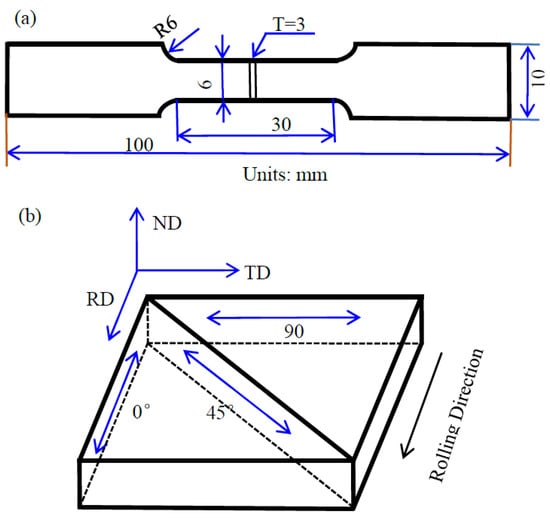
Figure 1.
Schematic diagrams of specimen size (a) and specimen orientation (b).
The solution treatment and artificial aging treatment were conducted in a muffle furnace and oil bath furnace. The heat treatment processes of the specimen are presented in Figure 2 and Table 2. The specimens were divided into three batches. The first batch of specimens was treated with the solid solution at 535 °C/1.5 h, and then water quenching was carried out. The specimen in this batch was called the SST specimen. The second batch of specimens was artificial aging treated at 180 °C/8 h after SST. Subsequently, an air cooling method was utilized to cool the specimen, which was named the AAT specimen. The third batch specimen was first SST-treated, then the deep cryogenic treatment was carried out at −196 °C/24 h, followed by 180 °C/8 h artificial aging treatment. In the current study, it was called the deep cryogenic-aging treatment (DCAT) specimen.
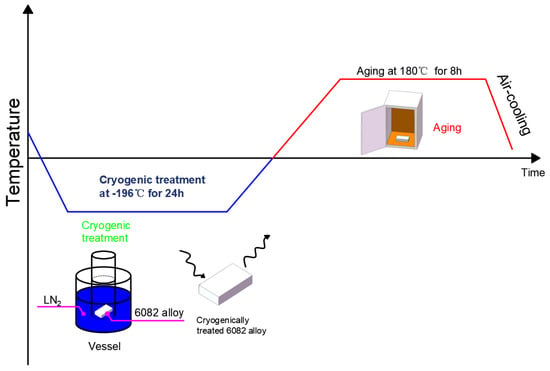
Figure 2.
The illustration of the heat treatment process.

Table 2.
Parameters of the heat treatment processes.
After heat treatment, all specimens were polished with sandpaper. Subsequently, the tensile experiment was carried out using an Instron universal testing machine at room temperature (about 25 °C) with a strain rate of 0.001 s−1. In order to guarantee the accuracy of the experimental results, three repetitive tensile tests were conducted for each condition. The stress–strain curves are the average results of three effective curves.
The microstructure characterization areas of the specimen are shown in Figure 3. For the scanning electron microscopy (SEM) specimen, a small area of the tensile specimen was cut near the fracture to observe the fracture morphology. Before SEM observation, the specimen was cleaned with alcohol. The fracture morphology was observed using an EVO-18 scanning electron microscope. In order to prepare the optical microscope (OM) observation specimen, a small part of the tensile specimen near the fracture was cut. Then, the specimen was ground by sandpaper with 600#, 1000#, and 2000#, respectively. The polished specimen was utilized to obtain a scratch-free surface. Subsequently, electrolytic corrosion by anodic coating was carried out. The electrolyte was a 5% (volume fraction) fluoroborate aqueous solution. During the anodic coating process, the voltage was 20 V, and the electrolysis time was 1~3 min. Finally, the AX10 Zeiss metallographic microscope was employed to observe the specimen and capture the OM results. For preparing transmission electron microscopy (TEM) specimens, a thin slice was taken near the fracture surface of the tensile specimen. The thin slice specimen was then mechanically thinned to 0.07 mm. Then, a wafer specimen with a 3 mm diameter was punched out. Subsequently, via the MIP-1A magnetic drive double spray thinning instrument, the specimen was thinned and perforated. During the double spray process, the solution was a methanol–nitric acid solution with a volume ratio of 7:3, and the temperature was set at −30 to −20 °C, accompanied by 20 V voltage. Finally, the specimen was observed with Tecnai G2 F20 (provided by FEI Company from the Hillsboro, OR, USA) transmission electron microscopy. The operating voltage of the TEM was 200 kV.

Figure 3.
Diagram of the specimen microstructural observation zone.
3. Experimental Results and Discussion
3.1. True Stress–True Strain Curves
Figure 4 exhibits the true stress–strain curves of 6082 aluminum alloy after different heat treatment processes. The curves were acquired by tensile test at room temperature and at a strain rate of 0.001 s−1. In the initial stage of tensile deformation, the specimens underwent elastic deformation. In general, the true stresses of the alloy experienced a rapid increase. As shown in Figure 4a, is the true stress–true strain curves of the as-received 6082 aluminum alloy sheet. The yield strengths of the alloy were 286 MPa, 277 MPa, and 281 MPa along the 0°, 45°, and 90° directions, respectively. Through comparison of Figure 4b–d, it can be found that the yield strengths of 6082 aluminum alloy with SST are comparatively lower. The yield strengths in all three directions were less than 200 MPa. However, the yield strengths of AAT and DCAT specimens were over 330 MPa.
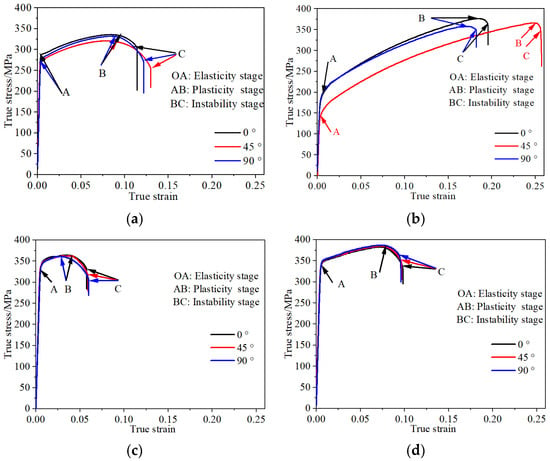
Figure 4.
The true stress–strain curves under different heat treatment processes: (a) as-received; (b) SST; (c) AAT; and (d) DCAT.
With continuing tensile deformation, the alloy enters the plastic deformation stage; microstructural evolution is the result of competition between hardening and softening effects. During this stage, the work hardening effect plays a leading role, which is caused by the rapid proliferation and congestion of dislocations [25], and the effect of dynamic softening is not sufficient. The dislocation annihilation caused by dynamic softening cannot offset the dislocation generation caused by work hardening. Thus, in all conditions, the true stress maintains an increasing tendency. The growth trend of the true stress was relatively gentle for AAT and DCAT specimens, compared to that of the SST specimen. Namely, the effect of strain strengthening on SST specimens was remarkable. After reaching the tensile strength, specimens in all conditions entered the instability stage. As the amount of tensile deformation further increased, the specimen went through the fracture failure stage. The corresponding elongation of the as-received alloy was between 10% and 15%. The elongation of the SST specimen was the highest, above 16%, while elongations of the AAT and DCAT specimens were less than 10%.
The anisotropic mechanical properties of the alloy can be revealed by the relationship between the yield strength and the specimen orientation, as presented in Figure 5. It can be seen that for SST specimens, the yield strength showed a V-shaped along with the increasing angle. The yield strengths at 0° and 90° reached 195 MPa and 196 MPa, respectively, while that at 45° was only 172 MPa. For as-received, AAT, and DCAT specimens, yield strengths in three directions showed little difference, and the relationship between yield strength and angle showed a parallel trend. The yield strengths of AAT specimens were 344 MPa, 343 MPa, and 341 MPa for 0°, 45°, and 90° specimens, respectively. In the DCAT condition, the yield strengths were 347 MPa, 348 MPa, and 350 MPa, respectively.
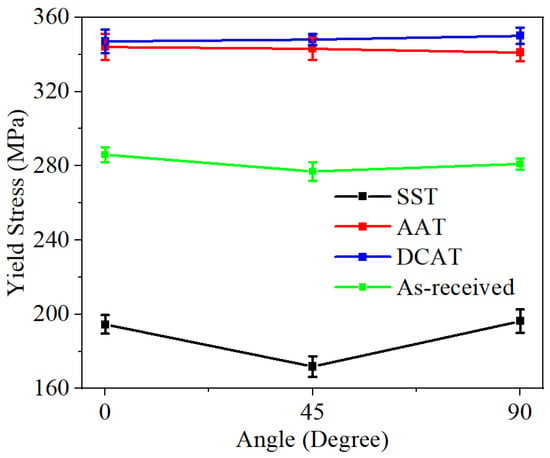
Figure 5.
The relationship between yield strength and specimen orientation.
In order to quantify the anisotropy of mechanical properties, an indicator of IPA (in-plane anisotropy) is generally adopted to describe the anisotropy of mechanical properties of aluminum alloy sheets [26]. It can be formulated as:
where YS(0), YS(45), and YS(90) are the yield strengths of specimens in 0°, 45°, and 90° directions at room temperature. The IPA values with different heat treatment conditions are exhibited in Table 3. It can be observed that the IPA value of the as-received alloy is 1.58%. The IPA value in the SST condition is the highest, reaching 5.40%, and the IPA values in AAT and DCAT conditions are 0.58% and 0.61%, respectively. In the AAT and DCAT processes, high volume fractions of precipitates were formed; during the slips of dislocation, the dislocations bypass the precipitates, and the number of slip systems will increase accordingly. The slip mechanism is transformed from coplanar slip to cross slip. This will result in the homogenization deformation of the alloy. As a consequence, the anisotropy of yield strength caused by the elongated grains of the aluminum alloy can be suppressed [27].

Table 3.
The IPA values (%) of the 6082 aluminum alloy with different heat treatment conditions.
3.2. Fracture Morphology
Figure 6 shows the fracture morphology of the deformed specimens in different directions with different heat treatment processes. It can be concluded from Figure 6 that the studied 6082 aluminum alloy showed typical ductile trans-granular fracture. A great number of dimples appear at the fracture, and the plastic deformation modes in different conditions are mainly dislocation slips. Figure 6a–c show the tensile fracture morphology with SST condition at 0°, 45°, and 90° respectively. The fracture characteristics of the specimens in the three directions are consistent. A large number of dimples can be found, and dimples are very deep with a large size, indicating that the alloy has an excellent plastic deformation ability. Figure 6d–i show the tensile fracture morphology with AAT and DCAT conditions at 0°, 45°, and 90° respectively. It can be seen that the dimples become shallower with a smaller size. Thus, it can be concluded that both AAT and DCAT processes suppress the plastic deformation ability of the alloy. The reason is that, during the aging process, a large amount of precipitates are formed. The precipitates will hinder the movement of dislocation [28,29,30]. This may form a potential stress concentration point. As a result, the tensile specimens are prone to failure. In addition, during the tensile process at room temperature, the dislocation accumulates and multiplies within the grain or at the boundary of a coarse second phase. Those locations tend to form new local stress concentration points and lead to the initiation of micro-cracks. As the growth of tensile deformation amounts, the micro-cracks continue to expand and converge to form the main crack. Finally, it triggers the fracture of the alloy materials.
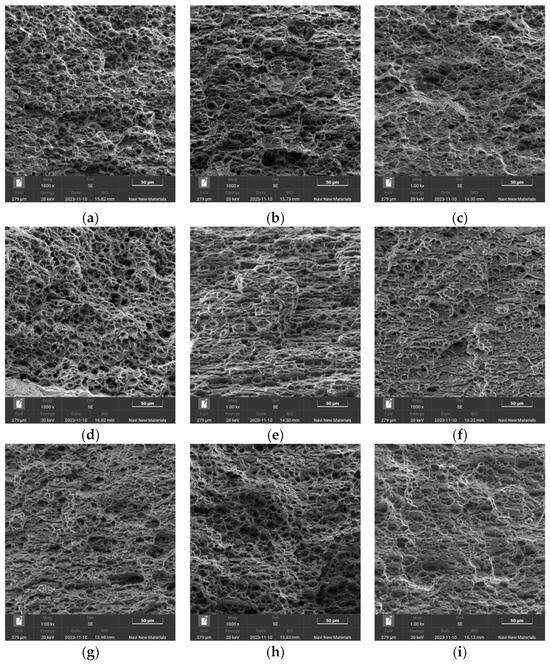
Figure 6.
The fracture morphology of 6082 aluminum alloy with different heat treatment conditions: (a) SST 0°; (b) SST 45°; (c) SST 90°; (d) AAT 0°; (e) AAT 45°; (f) AAT 90°; (g) DCAT 0°; (h) DCAT 45°; and (i) DCAT 90°.
3.3. Microstructure Observation
Figure 7 shows the grain distribution of the 0° specimen under different heat treatment conditions before tensile tests. It can be seen that under the effect of external force, all the grains are distributed along the rolling direction, showing elongated grains. The initial grain distributions with different heat treatment conditions show little difference, and the average width of elongated grain is about 10 µm. Thus, the heat treatment parameters adopted in the current study have little effect on the grain size and morphology. According to reference [31], the elongated grain will result in anisotropy of the material. The density of the grain boundary varies at different loading directions; the 0° direction has the highest density of grain boundary, resulting in higher deformation resistance. However, the accumulation of the dislocations cannot relax the stress concentration caused by the dislocations, making the material more prone to fracture under external forces and resulting in poor plasticity in the 0° direction. The strength is relatively high along the direction of the elongated grain, while the strength in the 45° direction from the elongated grain is relatively lower. In the current study, the mechanical properties of SST specimens conform to this tendency. However, after aging treatment, the anisotropy trend was weakened. The reason will be discussed subsequently.
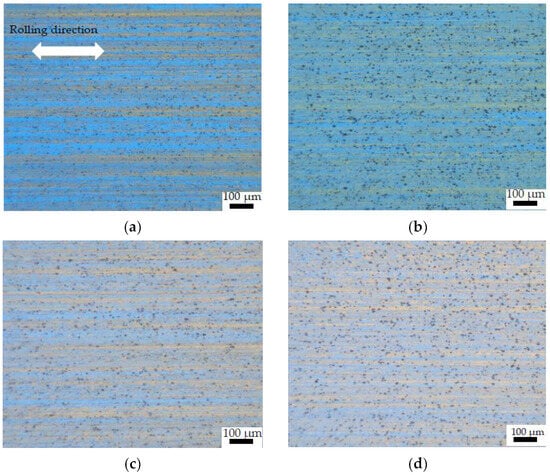
Figure 7.
The microstructure of the 6082 aluminum alloy with different heat treatment conditions before the tensile test: (a) as-received; (b) SST; (c) AAT; and (d) DCAT.
The grain structures of the specimens around the tensile fracture surface with different heat treatment conditions are shown in Figure 8. As shown in Figure 8a–c, the plastic deformation ability of the alloy is greatly improved by the SST process, which manifests with the higher elongation. The grain structures of the specimens are significantly elongated, and shear fracture occurs along the 45° direction of the specimen at the fracture point. For AAT and DCAT specimens, the deformation of the grain is lower than that of the SST specimen, indicating a decrease in deformation ability. Comparatively, the fracture of the SST specimen has a smooth transition, while the fractures of the AAT and DCAT specimens show obvious zigzag patterns. It also demonstrates a poor plastic deformation ability of AAT and DCAT specimens.


Figure 8.
The microstructure near fracture of the 6082 aluminum alloy with different heat treatment conditions after the tensile experiment (a) SST 0°; (b) SST 45°; (c) SST 90°; (d) as-received 0°; (e) AAT 0°; and (f) DCAT 0°.
Figure 9 shows TEM images of the 6082 aluminum alloy with different heat treatment conditions before the tensile test. After different heat treatment processes, the size and density of precipitates in the aluminum alloy matrix are different. As shown in Figure 9a, in the as-received alloy, a certain number of needle-like β″ precipitates are observed. The number density is 1575/mm2. In the SST specimen, no obvious precipitates are apparent in Figure 9b; they dissolved into the matrix during the SST process. For AAT and DCAT specimens, the needle-like β″ precipitates are uniformly distributed with a high density, as shown in Figure 9c,d. The number densities for AAT and DCAT specimens are 3350/mm2 and 4850/mm2, respectively. A similar result was reported by Miao et al. [32]. It is acknowledged that precipitates can restrict the motion of dislocations by glide in the slip planes of matrix; dislocation climbing is a thermally activated process [33]. In addition, after deep cryogenic treatment, the density of precipitates increases, and the distribution of precipitates becomes more uniform. There are two reasons for this phenomenon. Firstly, the cryogenic temperature induces the shrinkage of the lattice and lattice constant, which results in an increase in supersaturation of the solute atoms. Therefore, the driving force of solute atom precipitation is improved. Secondly, at deep cryogenic temperature, the equilibrium concentration of vacancy in the alloy is low. A long-term low-temperature atmosphere not only further reduces the vacancy concentration, but also promotes the precipitation of solute atoms [34]. It is expected that the stress required for passing dislocations would be improved with an increase in the density of precipitates and a decrease in the mean free path for dislocation motion. The results show that the anisotropy of mechanical properties can be reduced by small precipitates [35]. The habitus plane of the β″ phase is along the <100> direction. It uniformly precipitated within the grain with a large ratio of long and short axes. During tensile deformation, the interaction between dislocation and precipitates varies at different heat treatment conditions. The anisotropy caused by elongated grains is partially suppressed. The high densities of precipitates in AAT and DCAT specimens are the main reason for the higher strength and lower anisotropy of the studied alloy. Therefore, for the SST specimen, there are no obvious precipitates in the matrix and its anisotropy is outstanding. For the AAT and DCAT specimens, with the distinct increase in precipitate density, its inhibition effect on anisotropy is further increased.
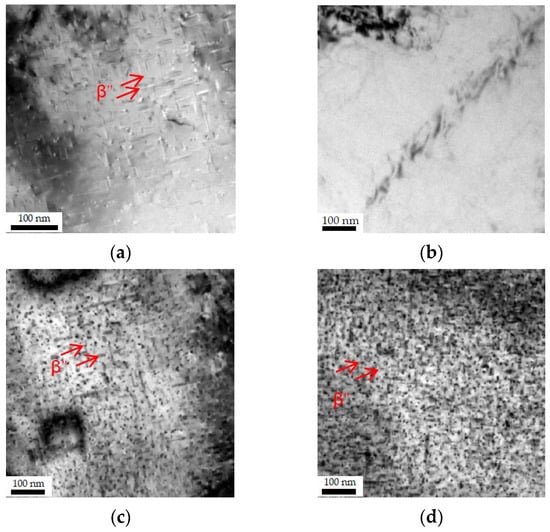
Figure 9.
TEM images of 6082 aluminum alloy with different heat treatment conditions before the tensile test: (a) as-received; (b) SST; (c) AAT; and (d) DCAT.
Figure 10 shows TEM images of 6082 aluminum alloy with different heat treatment conditions after the tensile test. It can be seen that specimens with different heat treatment processes show relatively high density of dislocation after tensile deformation. It is reported that the dislocation density is affected by the size and distribution of precipitates [36]. The precipitates in AAT and DCAT alloys have an excellent strengthening effect. In the process of tensile deformation, it can effectively hinder the movement of dislocation. Therefore, as shown in Figure 10c,d, it induces the phenomenon of dislocation accumulation and leads to a relatively high dislocation density. For the as-received alloy, the number density of the precipitate is lower than those of AAT and DCAT. Therefore, the density of the dislocation shows a declining trend in Figure 10a. Compared with as-received specimens, as shown in Figure 10b, the dislocation density of SST specimens is relatively lower, because there are no obvious precipitates in the matrix.
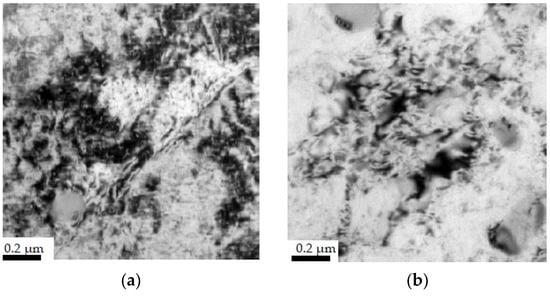
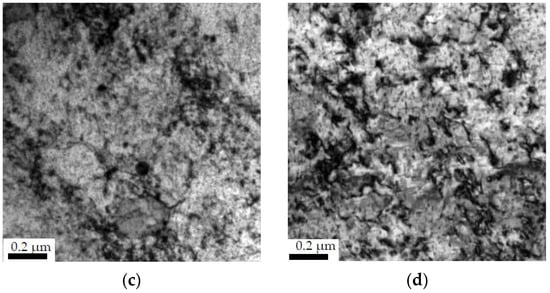
Figure 10.
TEM images of the 6082 aluminum alloy with different heat treatment conditions after the tensile test: (a) as-received; (b) SST; (c) AAT; and (d) DCAT.
4. Conclusions
The tensile behaviors of 6082 aluminum alloys with different heat treatment conditions have been explored. The microstructure mechanism for the strengthening effect and anisotropic mechanical properties have been investigated and analyzed. The conclusions are as follows:
- The yield strength of 6082 aluminum alloy after artificial aging treatment is significantly higher than that of solid solution treatment alloy; the yield strengths in three directions are around 340 MPa, because the precipitates in the matrix can effectively pin the dislocation and improve the deformation resistance. The yield strength of the 6082 alloy treated by the deep cryogenic aging process is slightly higher than that of artificially aged alloy because deep cryogenic treatment can promote the nucleation and precipitation of precipitates.
- The studied alloys in three different heat treatment conditions show ductile fracture characteristics. The elongation of the solid solution treatment alloy is over 16%; the fracture dimples are deep with high quantity. The elongation of artificially aged and cryogenic aged alloys is lower, and the dimple is shallower with a smaller size. The precipitates are potential stress concentration points during the tensile deformation process, which may lead to failure of the material.
- The solid solution alloy shows obvious mechanical properties of anisotropy, which is caused by the elongated grain. The anisotropy of artificially aging and deep cryogenic aging treatment alloys is not obvious. The reason is that the precipitates has a habitus plane; the large ratio of long and short axes during plastic deformation can inhibit the anisotropy caused by elongated grains.
Author Contributions
Conceptualization, T.Y. and E.X.; Methodology, Y.W. and J.L. (Jie Liu); Data curation, E.X. and J.L. (Jie Liu); Formal analysis, T.Y. and J.L. (Jiahao Luo); Funding acquisition, Y.W.; Investigation, S.Q. and L.S.; Resources, J.L. (Jiahao Luo) and L.S.; Writing—original draft, E.X. and T.Y.; Validation, S.Q. and J.L. (Jie Liu); Visualization, L.S. and J.L. (Jiahao Luo); Supervision Y.W.; Writing—review and editing, E.X. and S.Q. All authors have read and agreed to the published version of the manuscript.
Funding
The authors gratefully acknowledge financial support from the National Natural Science foundation of China [52201074, 52171115], Scientific Research Fund of Hunan Provincial Education Department of China [22A0626, 22B0867] and the Scientific Research Project of Hunan Institute of Technology (grant number HQ22010).
Institutional Review Board Statement
Not applicable.
Informed Consent Statement
Not applicable.
Data Availability Statement
Data are contained within the article.
Conflicts of Interest
The authors declare no conflicts of interest.
References
- Xu, X.; Zhu, W.; Yuan, M.; Liang, C.; Deng, Y. The effect of Zn content on the microstructure and mechanical properties of the Al-mg-Si alloy. Mater. Charact. 2023, 198, 112714. [Google Scholar] [CrossRef]
- Li, S.; Yue, X.; Li, Q.; Peng, H.; Dong, B.; Liu, T.; Yang, H.; Fan, J.; Shu, S.; Qiu, F.; et al. Development and applications of aluminum alloys for aerospace industry. J. Mater. Res. Technol. 2023, 27, 944–983. [Google Scholar] [CrossRef]
- Liu, S.; Xu, G.; Jin, J.; Li, Y.; Peng, X. Good combination of strength and mechanical isotropy in AA6082 alloy processed by high temperature intermediate annealing. J. Alloys Compd. 2022, 922, 166229. [Google Scholar] [CrossRef]
- Khangholi, S.; Javidani, M.; Maltais, A.; Chen, X. Review on recent progress in Al-Mg-Si 6xxx conductor alloys. J. Mater. Res. 2022, 37, 670–691. [Google Scholar] [CrossRef]
- Dash, S.; Li, D.; Zeng, X.; Chen, D. Heterogeneous microstructure and deformation behavior of an automotive grade aluminum alloy. J. Alloys Compd. 2021, 870, 159413. [Google Scholar] [CrossRef]
- Agustín-Sáenz, C.; Coloma, P.; Francisco, J.; Brusciotti, F.; Brizuela, M. Design of Corrosion Protective and Antistatic Hybrid Sol-Gel Coatings on 6XXX AlMgSi Alloys for Aerospace Application. Coatings 2020, 10, 441. [Google Scholar] [CrossRef]
- Winter, L.; Lampke, T. Influence of Hydrothermal Sealing on the High Cycle Fatigue Behavior of the Anodized 6082 Aluminum Alloy. Coatings 2022, 12, 1070. [Google Scholar] [CrossRef]
- Xu, X.; Deng, Y.; Shuiqing, C.; Xiaobin, G. Effect of interrupted ageing treatment on the mechanical properties and intergranular corrosion behavior of Al-Mg-Si alloys. J. Mater. Res. Technol. 2020, 9, 230–241. [Google Scholar] [CrossRef]
- Siddesh-Kumar, N.; Dhruthi; Pramod, G.; Samrat, P.; Sadashiva, M. A Critical Review on Heat Treatment of Aluminium Alloys. Mater. Today Proc. 2022, 58, 71–79. [Google Scholar] [CrossRef]
- Yao, S.; Tang, Q.; Yang, J.; Wang, C.; Sun, H.; Rong, R.; Sun, H.; Chu, G. Microstructural characterization and mechanical properties of 6061 aluminum alloy processed with short-time solid solution and aging treatment. J. Alloys Compd. 2023, 960, 170704. [Google Scholar] [CrossRef]
- Pogatscher, S.; Antrekowitsch, H.; Leitner, H.; Ebner, T.; Uggowitzer, P. Mechanisms controlling the artificial aging of Al–Mg–Si Alloys. Acta Mater. 2011, 59, 3352. [Google Scholar] [CrossRef]
- Mohammadi, M.; Ashtiani, H. Influence of Heat Treatment on the AA6061 and AA6063 Aluminum Alloys Behavior at Elevated Deformation Temperature. Iran. J. Mater. Sci. Eng. 2021, 18, 1–17. [Google Scholar] [CrossRef]
- Amel-Soula, A.; Jean-Philippe-Couzinié, B.; Hanen-Heni, A.; Julie-Bourgon, B.; Yannick-Champion, B.; Nabil-Njah, A. Activation Volume and the role of solute atoms in Al-Mg-Si alloy processed by Equal Channel Angular Extrusion. J. Alloys Compd. 2022, 899, 163334. [Google Scholar] [CrossRef]
- Kang, H. Influence of the solution and artificial aging treatments on the microstructure and mechanical properties of die-cast Al–Si–Mg alloys. Metals 2022, 12, 71. [Google Scholar] [CrossRef]
- Yin, Q.; Jiang, L.; Guo, F.; Wang, Z. Microstructure and Properties of 6 Series Aluminum Alloy Under Different Aging Treatment Systems. Mater. Sci. 2023, 29, 439–444. [Google Scholar] [CrossRef]
- Prathap, S.; Tittugeorge, D.; Anittojoexavier, A.; Abinicksraja, G. Effect of heat treatment on the hardness behaviour of the aluminium 6061 alloy. Mater. Today Proc. 2023, 02, 1–5. [Google Scholar] [CrossRef]
- Guo, J.; Jin, M.; Su, R.; Li, G.; Qu, Y. Microstructural morphology and mechanical properties of deep cryogenic treatment modified Al-Cu-Mg-Ag alloy. Mater. Today Commun. 2024, 38, 1–11. [Google Scholar] [CrossRef]
- Jovičevićklug, M.; Rezar, R.; Jovičevićklug, P.; Podgornik, B. Influence of deep cryogenic treatment on natural and artificial aging of Al-Mg-Si alloy EN AW 6026. J. Alloys Compd. 2022, 899, 163323. [Google Scholar] [CrossRef]
- Yuanchun, H.; Li, Y.; Ren, X.; Xiao, Z. Effect of Deep Cryogenic Treatment on Aging Processes of Al–Mg–Si Alloy. Phys. Met. Metallogr. 2019, 120, 914–918. [Google Scholar] [CrossRef]
- Barnwal, V.; Raghavan, R.; Tewari, A.; Narasimhan, K.; Mishrasushil, K. Effect of microstructure and texture on forming behaviour of AA-6061 aluminium alloy sheet. Mater. Sci. Eng. A 2017, 679, 56–65. [Google Scholar] [CrossRef]
- Naga, K.; Ashfaq, M.; Susila, P.; Sivaprasad, K.; Venkateswarlu, K. Mechanical anisotropy and microstructural changes during cryorolling of Al-Mg-Si alloy. Mater. Charact. 2015, 107, 302–308. [Google Scholar] [CrossRef]
- Qiu, S.; Xia, E.; Liu, L.; Ye, T.; Liu, J.; Tang, J.; Liu, W.; Wu, Y. Tensile Behavior and Microstructure Evolution of an Extruded 6082 Aluminum Alloy Sheet at High Temperatures. Metals 2024, 14, 7. [Google Scholar] [CrossRef]
- Liu, W.; Wu, Y.; Deng, B.; Liu, A.; Liu, W.; Sun, Q.; Ye, T. Effect of Aging Processes on the Anisotropic Mechanical Property of 6061 Aluminum Alloy and the related Microstructure Evolution. Mater. Rep. 2021, 35, 04138. [Google Scholar]
- Briseno, J.; Casanova-Del-Angel, F. Fracture Mechanics on Aluminum Specimens. World J. Mech. 2021, 11, 011–019. [Google Scholar] [CrossRef]
- Guo, Y.; Zhang, J. Microstructure evolution and mechanical responses of Al–Zn–Mg–Cu alloys during hot deformation process. J. Mater. Sci. 2021, 56, 13429–13478. [Google Scholar] [CrossRef]
- Shen, F.; Yi, D.; Wang, B.; Liu, H.; Jiang, Y.; Tang, C.; Jiang, B. Semi-quantitative evaluation of texture components and anisotropy of the yield strength in 2524 T3 alloy sheets. Mater. Sci. Eng. A 2016, 675, 386–395. [Google Scholar] [CrossRef]
- Jin, S.; Gai, T.; Zhang, G.; Zhai, T.; Jia, S. Precipitation strengthening mechanisms during natural ageing and subsequent artificial aging in an Al-Mg-Si-Cu alloy. Mater. Sci. Eng. A 2018, 724, 53–59. [Google Scholar] [CrossRef]
- Lipinska, M.; Chrominski, W.; Olejnik, L.; Golinski, J.; Rosochowski, A.; Lewandowska, M. Ultrafine-Grained Plates of Al-Mg-Si Alloy Obtained by Incremental Equal Channel Angular Pressing: Microstructure and Mechanical Properties. Metall. Mater. Trans. A 2017, 48A, 1–12. [Google Scholar] [CrossRef]
- Zhao, N.; Ma, H.; Hu, Z.; Yan, Y.; Chen, T. Microstructure and mechanical properties of Al-Mg-Si alloy during solution heat treatment and forging integrated forming process. Mater. Charact. 2022, 185, 111762. [Google Scholar] [CrossRef]
- Sun, L.; Lin, C.; Fan, Z.; Li, H.; Yao, S. Experimental and numerical investigation on axial hydro-forging sequence of 6063 aluminum alloy tube. Int. J. Adv. Manuf. Technol. 2019, 105, 2869–2877. [Google Scholar] [CrossRef]
- Naumenko, K.; Gariboldi, E. Experimental analysis and constitutive modeling of anisotropic creep damage in a wrought age-hardenable Al alloy. Eng. Fract. Mech. 2021, 259, 108119. [Google Scholar] [CrossRef]
- Miao, W.; Laughlin, D. A differential scanning calorimetry study of aluminum alloy 6111 with different pre-aging treatments. J. Mater. Sci. Lett. 2000, 19, 201–203. [Google Scholar] [CrossRef]
- Bagui, S.; Sahu, B.; Laha, K.; Tarafder, S.; Mitra, R. Creep Deformation Behavior of Inconel 617 Alloy in the Temperature Range of 650 degrees C to 800 degrees C. Metall. Mater. Trans. A Phys. Metall. Mater. Sci. 2021, 52, 94–107. [Google Scholar] [CrossRef]
- Li, K.; Wang, D.; Deng, L.; Jin, J.; Gong, P.; Wang, X. Research progress of low temperature performance and cryogenic treatment of high entropy alloys. Chin. J. Nonferr. Met. 2022, 32, 1237–1253. [Google Scholar]
- Chrominski, W.; Wenner, S.; Marioara, C.; Holmestad, R.; Lewandowska, M. Strengthening mechanisms in ultrafine grained Al-Mg-Si alloy processed by hydrostatic extrusion—Influence of ageing temperature. Mater. Sci. Eng. A 2016, 669, 447–458. [Google Scholar] [CrossRef]
- Wang, J.; Xie, J.; Ma, D.; Mao, Z.; Liang, T.; Ying, P.; Wang, A.; Wang, W. Effect of deep cryogenic treatment on the microstructure and mechanical properties of Al–Cu–Mg–Ag alloy. J. Mater. Res. Technol. 2023, 25, 6880–6885. [Google Scholar] [CrossRef]
Disclaimer/Publisher’s Note: The statements, opinions and data contained in all publications are solely those of the individual author(s) and contributor(s) and not of MDPI and/or the editor(s). MDPI and/or the editor(s) disclaim responsibility for any injury to people or property resulting from any ideas, methods, instructions or products referred to in the content. |
© 2024 by the authors. Licensee MDPI, Basel, Switzerland. This article is an open access article distributed under the terms and conditions of the Creative Commons Attribution (CC BY) license (https://creativecommons.org/licenses/by/4.0/).